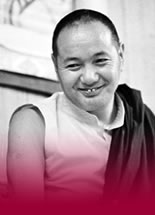Robina’s Blog
8 June, 2023
There's a very detailed description of the death process that's described in the Vajrayana, in terms of eight stages. It's a gradual process of the deconstruction of the various components that make us up as a person, physical and mental. The great yogis have complete control over this process, both dying and being reborn, and choosing their new rebirth. We can learn it too. Lama Zopa Rinpoche talks about it in How to Face Death without Fear.
Interestingly, we go through these same stages every time we go to sleep, but we're not conscious. The stages are named in relation to a subtle vision at each stage.
1. A mirage. The earth element ceases. The first thing to cease functioning is your earth element. We can see when we’re wide awake and wound up, the earth element has the function of the weight and the heaviness and the strength of the body. And then when you’re beginning to become tired your body gets very heavy, doesn’t it? It feels very heavy.
Eye consciousness ceases. At the same time, the eye consciousness ceases to function. Now you check this. You’re sitting there talking to someone and you’re becoming very tired and you’re struggling to stay awake as they’re talking to you, right? And your eyes are open but you’re really struggling and you’re not really seeing them, are you? Because what is happening is your eye consciousness is ceasing to function, it’s absorbing inwards.
The mirror-like wisdom ceases. Your ability to see many things at once gradually ceases. A vision of a mirage occurs. It's a bit like the interplay between earth and water.
2. Smoke. Next, the water element ceases. The liquid in the body begins to dry up. The ear consciousness ceases. We have that experience when we’re tired. I’m listening to a friend but suddenly I lost that last fifteen seconds; I have no memory of what she said because I didn’t hear it: your ear consciousness is ceasing to function.
The wisdom of equanimity ceases. At the same time there is this capacity of the mind to distinguish between pleasure, pain, and indifference. When you’re nodding off to sleep, who cares? Normally this very vivid capacity we have to be able to distinguish in daily life when we’re wide awake is not so clear now. And the vision here is sort of smoky, a bit like the interplay between water and the next one, which is fire.
3. Sparks. The next stage is the nose consciousness ceases to function. The wisdom of discriminating awareness ceases: the capacity to distinguish between this and that and now, in particular, between friends, enemies, and strangers. Aunty Jane over there, whom you adore; and mean old cousin Fred over there, whom you can't stand. Whereas in life, very vivid: enemies, friends, strangers.
The fire element ceases. The nose element, the nose consciousness, the smell, and the fire element now, the heat in the body begins to cease. A vision of fire sparks. And the vision here, what you see is sparks. It’s like an interplay of fire and air. They say it’s like fireflies, sparks in a fire.
By now you can’t hear, you can’t see, your earth element has ceased, your body’s like lead and can’t move, the water element, the heat element, they’ve ceased. We're gradually ceasing.
4. Flame. Now, the next stage is the breathing stops. Even through this process, the breathing is getting heavier, the out breaths are getting longer, the in breaths are getting shorter and now what happens is the breath goes out and no longer comes in. The air element ceases. The tongue consciousness, taste, ceases. And the tongue now turns blue at the root and gets very short. As Geshe Rabten said: “This tongue, which spent its life gossiping, is now useless.”
The all-accomplishing wisdom ceases. The capacity of the mind to even know who you are, what’s important, in other words this whole sense of self, who I am, that we hold so strongly when we’re wide awake and alive, all this sense of me and my life, this is finished. No longer any sense of who you are, the importance of anything. Forget it, all gone.
By now you’re ready for the body bag; as far as the West is concerned, you’re dead. But you’re not dead yet, according to the Buddhist view. By the time you stop breathing, it could be a couple more days before your consciousness leaves.
Now, your gross consciousness and the body that comes along with the gross consciousness, which is like the vehicle of that consciousness, the grosser level has ceased completely. Ideally, leave the body undisturbed – whether it's your pussycat, your mother, or yourself.
5, 6, and 7. White, red, dark vision. Now the subtle consciousness gradually ceases, and this is mainly the various mental states, which are more subtle than the sensory consciousness, along with the various winds related to them: they all enter into the central channel.
The physical components at this level are the 72,000 subtle nervous system, the wind energies that course through those subtle channels, inextricably linked with the various mental states. They say that the mind rides on the winds.
There's the central channel, two side channels, and all the others. Where various channels meet at various points along the central channel, constricting the channels: these are called chakras.
And then there is what they call the drops, or kundalini. These red and white drops—contained within the egg and the sperm from our parents—are what the consciousness joins at the time of conception and they remain throughout life at the heart chakra.
8. Clear light. Finally, all that's left is the very subtle consciousness, or the clear light consciousness, at the heart chakra, linked inextricably with the extremely subtle body, the wind energy. They join the indestructible drop at the heart chakra, the red and white kundalini.
You can stay here, unconscious, for up to three days. The great yogis are totally conscious at this subtle level. As Lama Zopa Rinpoche says in How to Face Death Without Fear, "this is what the yogis have been waiting for." They can use this subtle level of mind to actually become enlightened, and they can meditate for days, weeks. Rinpoche meditated for more than two days before he decided to leave his body.
The next rebirth. Back at about the second stage of this process is when the karmic seed from the past that will determine your next rebirth is triggered.
If we spend our life being conscious, practicing being aware of impermanence, giving up attachment, giving up delusions, doing some practice, purifying our karma, then you could say that our death will be easy, our mind will be peaceful at the time of death and a positive karmic seed will be triggered, which will ripen as a human rebirth.
But if you've never thought about impermanence, are not conscious of your body, speech, and mind, and if there's masses of fear at the time of death, which is not uncommon, a negative seed will be triggered, which will ripen as a future suffering rebirth, such as an animal.
When the mind finally leaves the body, not more than three days after the breath stops, it will go through a reverse process of these eight stages and we'll experience what's called the intermediate state, which really is just like a dream. If you have the karma to be born human, basically you're waiting for your new parents to get together!
I remember one lama, in a very nice book called The Art of Tibetan Parenting, was quoted as saying that at the time of male and female human beings in sexual contact, billions of consciousnesses are all hovering about trying to get in!
Well, we got a human rebirth this time. So let's not waste it. Let's be ready for death so that we can carry on in another good life practicing our spiritual path.

